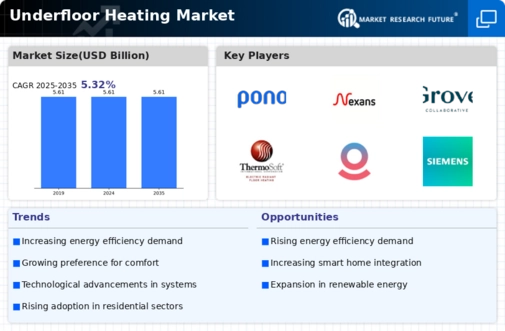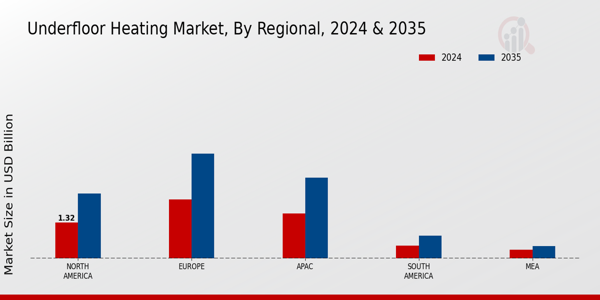Rising Construction Activities
The Global Underfloor Heating Market Industry is benefiting from a surge in construction activities, particularly in emerging economies. As urbanization accelerates, there is a growing need for modern heating solutions in new residential and commercial buildings. Underfloor heating systems are increasingly favored for their space-saving design and enhanced comfort. This trend is evident in various regions, where builders are incorporating underfloor heating into their projects to meet consumer preferences for efficient and comfortable living spaces. The consistent market value of 5.61 USD Billion in 2024 reflects this growing integration of underfloor heating in contemporary construction practices.
Growing Demand for Energy Efficiency
The Global Underfloor Heating Market Industry is experiencing a notable increase in demand for energy-efficient heating solutions. As consumers become more environmentally conscious, they seek systems that reduce energy consumption and lower utility bills. Underfloor heating systems, which operate at lower temperatures compared to traditional radiators, provide an efficient heating solution. This trend is reflected in the projected market value of 5.61 USD Billion in 2024, indicating a stable interest in sustainable heating options. Governments worldwide are also promoting energy-efficient technologies, further driving the adoption of underfloor heating systems in residential and commercial buildings.
Increased Awareness of Health Benefits
Awareness of the health benefits associated with underfloor heating is contributing to the growth of the Global Underfloor Heating Market Industry. Unlike traditional heating systems, underfloor heating minimizes dust circulation and allergens, creating a healthier indoor environment. This aspect is particularly appealing to families with children or individuals with respiratory issues. As more consumers recognize these advantages, the demand for underfloor heating systems is likely to rise. The market's stability at 5.61 USD Billion in 2024 suggests that health-conscious consumers are increasingly opting for underfloor heating solutions, which may further enhance their popularity in the coming years.
Technological Advancements in Heating Systems
Technological innovations are significantly influencing the Global Underfloor Heating Market Industry. The introduction of smart thermostats and advanced control systems allows for precise temperature regulation, enhancing user comfort and energy efficiency. These advancements enable homeowners to monitor and adjust their heating systems remotely, which is increasingly appealing in today's digital age. As a result, the market is expected to maintain its value at 5.61 USD Billion through 2035, with a projected CAGR of 0.0% from 2025 to 2035. This stagnation may suggest a mature market, yet the ongoing technological improvements could stimulate further interest and investment in underfloor heating solutions.
Regulatory Support for Sustainable Heating Solutions
Regulatory frameworks promoting sustainable heating solutions are playing a crucial role in the Global Underfloor Heating Market Industry. Governments are implementing policies that encourage the adoption of energy-efficient technologies, including underfloor heating systems. Incentives such as tax rebates and grants for energy-efficient home improvements are motivating consumers to invest in these systems. This regulatory support is expected to sustain the market's value at 5.61 USD Billion through 2035, despite a projected CAGR of 0.0% from 2025 to 2035. Such initiatives not only foster market growth but also align with global efforts to reduce carbon emissions and combat climate change.























Leave a Comment